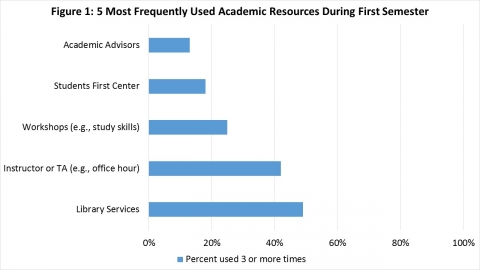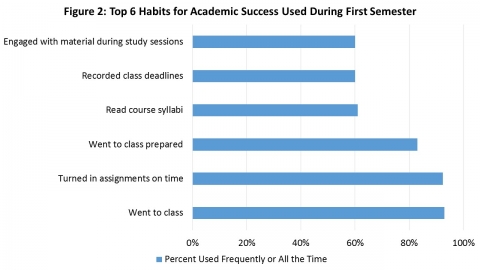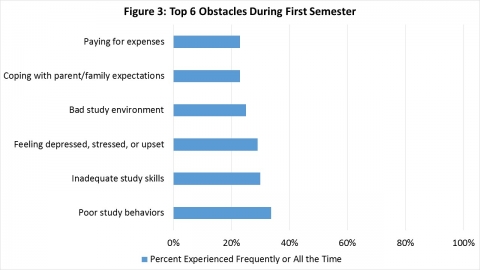New Students Reflect on Academic Successes and Challenges
In Fall 2016, new first-year and transfer students completed the annual UC Merced New Student Survey, which asks about their educational plans, transitions to college and utilization of campus services. The survey was completed by students shortly after midterms and had a 48 percent response rate. For new students, major tasks include: (1) finding and using campus resources, (2) developing habits that support their academic success, and (3) identifying obstacles to success.
Highlights from this year’s survey results, particularly regarding new students’ progress on these important tasks, are provided below.
Finding and using resources to support academic success: 87 percent felt somewhat or very sure that they could find resources that would help them overcome academic challenges and obstacles. Figure 1 shows the five academic resources most frequently used by new students in their first semester.

Developing habits that support academic success: 80 percent of new first-year students attended the ASCEND conference and 76 percent of new transfer students attended the TRANSCEND conference during Welcome Week. One goal of these conferences is to help new students identify habits for academic success that they can adopt. Figure 2 shows the top six habits for academic success that students reported engaging in during their first semester.

Identifying obstacles to success: Students also reflected on the obstacles they faced during the semester. Figure 3 shows the top six obstacles reported by students.

Further, the greater the number of obstacles students reported experiencing either frequently or all the time, the less likely they were to say they thought they could succeed academically (i.e., earn higher grades at the end of the semester) and find resources that would help them overcome academic challenges and obstacles.
It’s important to note that these relationships were quite small, suggesting that even students who perceive obstacles still believe that they can be successful and find resources to help them.
Patterns in student responses to these questions were also examined between the 2014, 2015 and 2016 entering student cohorts and few differences were found. A previous Panorama story summarizes the data for the 2014 and 2015 cohorts, although some of the survey items changed in 2016. A longitudinal report containing the 2014 and 2015 data (2016 data has not yet been added) is available online.
For questions about the New Student Survey or these data, contact Cinnamon Danube in Institutional Research and Decision Support. The full survey report can be found online.
